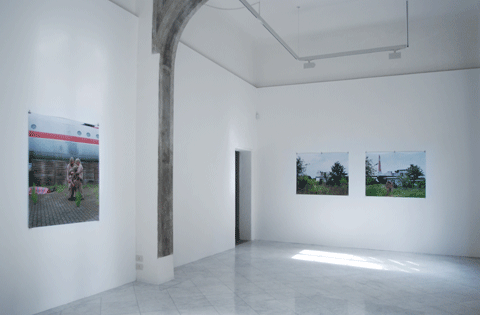Exhibitions
25 Sep 30 Oct 2009
Zone Edge (Lumpers and Splitters)
(e.) Twin Gabriel

The edge of something, the border, where one thing ends and something else begins, is in principle a critical region and is therefore of particular interest and often the subject of bitter arguments. However, in the border zone in central Germany, that is the area directly to the east and to the west of the wall which divided Germany until 1989, a timeless peace now reigns, a type of idleness or state of being on hold, in which everything seems possible, where many things have already failed and gone missing and other things are not even attempted.
During excavations in the former border zone area of Schöningen, the oldest wooden tools of the homo genus were found in 1996, wooden spears about 400,000 years old, which, depending on whether interpreted by researchers of the lumper camp or those of the splitter camp, may be attributed either to Homo erectus or to Homo heidelbergensis.
Else Gabriel grew up near to this area. In 2007, she went back to her old homeland with her partner Ulf Wrede, with whom she has been working artistically for 20 years under the name (e.) Twin Gabriel, and with their two children. The purpose was toexplore this border zone which is dramatically and deeply located in the evolution of humankind. In the self experiment, Else Gabriel presents herself and her family as an extinct species, as timeless revenants and ghostlike relatives – an unannounced visit, in which one does not exactly know, whereto, and whose temporary civilised appearance causes one a certain unease. In other words: almost the way that many of the German-German encounters felt after the first weeks of euphoria following the fall of the Wall in 1989…
Twin Gabriel call these approaches experimental anthropology and they are covering a wide range of investigative and artistic interests in 2009, the year commemorating the birth of Darwin and the fall of the Wall, in order to highlight the complexity and ambivalence, the ambiguity of individual feelings during times of upheaval and uncertainty.
In Florence, the city that houses the world’s first publicly accessible natural history museum, a real treasure trove with its collection of very old animal specimens, some of which are from species that are already extinct, Twin Gabriel present a selection from their tribute to Homo erectus and his kin with large-sized photographic works, video and audio sketches as well as three-dimensional works.
Else Gabriel (born in 1962 in Halberstadt) lives in Berlin and teaches at the Berlin-Weissensee School of Art. Her works have been exhibited internationally since the 1990’s (including at Malmö Konsthall; Palazzo delle Esposizioni, Rome; Martin Gropius-Bau, Berlin; Staatliche Kunsthalle Baden-Baden; South London Gallery and many others).



